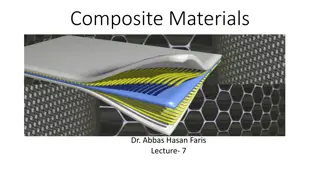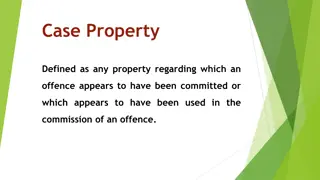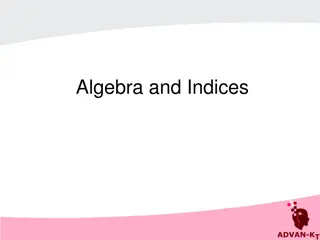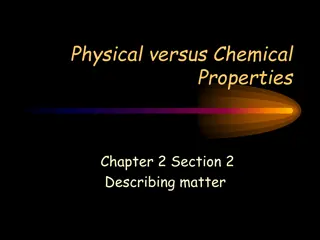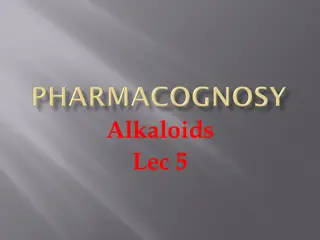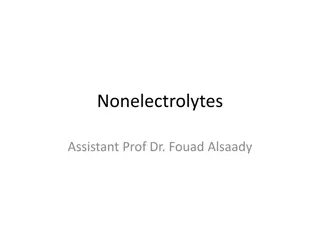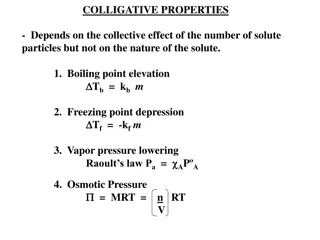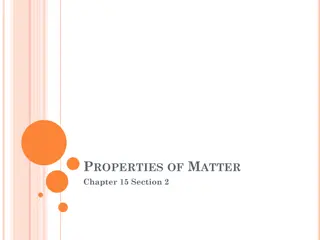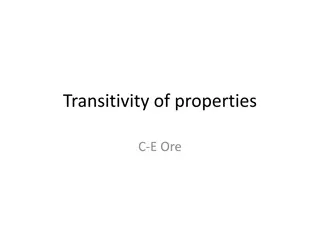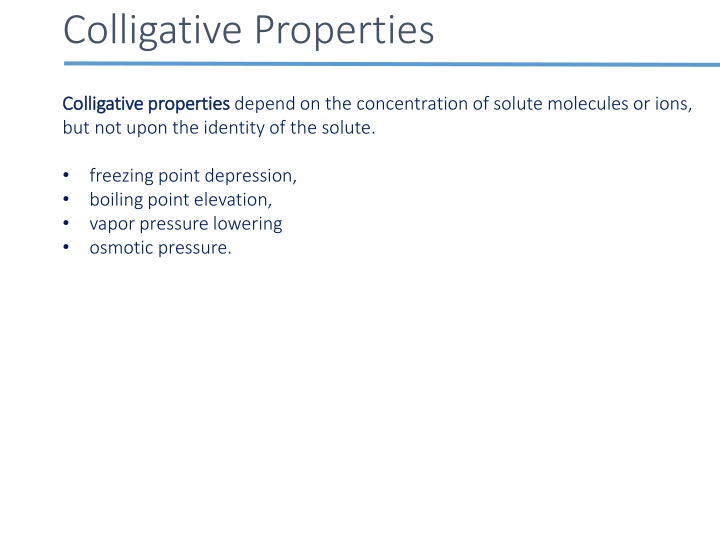
Colligative Properties and Raoult's Law in Solutions
Learn about colligative properties which depend on solute concentration, not identity, including freezing point depression and boiling point elevation. Explore how Raoult's Law helps predict vapor pressure in binary solutions based on mole fractions. Discover ideal solutions and the total pressure in binary mixtures, illustrated through graphical representations.
Download Presentation

Please find below an Image/Link to download the presentation.
The content on the website is provided AS IS for your information and personal use only. It may not be sold, licensed, or shared on other websites without obtaining consent from the author. If you encounter any issues during the download, it is possible that the publisher has removed the file from their server.
You are allowed to download the files provided on this website for personal or commercial use, subject to the condition that they are used lawfully. All files are the property of their respective owners.
The content on the website is provided AS IS for your information and personal use only. It may not be sold, licensed, or shared on other websites without obtaining consent from the author.
E N D
Presentation Transcript
Colligative Properties Colligative properties Colligative properties depend on the concentration of solute molecules or ions, but not upon the identity of the solute. freezing point depression, boiling point elevation, vapor pressure lowering osmotic pressure.
Raoults Law Consider a binary solution with a single liquid phase solute If we have a mixture of two liquids and we know the mole fraction of each, what other information do we need to know the total vapor pressure above the liquid and the composition of that vapor? It turns out, that in many cases all we need to know is the vapor pressure of the pure substances.
Raoults Law An ideal solution obeys Raoult s law Pj = xjPj0 the partial pressure in the vapor phase of each component of a mixture Pj equals the mole fraction of that component in the solution xj multiplied by the vapor pressure above a pure solution of that liquid xjPj0
Ideal Liquid In an ideal gases, molecules do not interact with each other. That cannot be the case for an ideal solution, because both solute and solvent molecules must be attracted to each other in the liquid, otherwise it would never condense. So what is an ideal solution? Well, we could use Raoult s law and define an ideal solution as a solution that obeyed Raoult s law, but a more physical one is that in an ideal solution, the interactions of solvent-solute are just the same as solvent-solvent in a pure solution. A little thought will show that as the concentration of solute goes to zero all solutions behave ideally. This means that the partial vapor pressure of any component of an ideal mixture varies linearly as the mole fraction in the liquid mixture.
Total Pressure in a Binary Mixture A binary mixture has two components. If they are both liquid PT =P1 +P2 According to Raoult s law P1=x1P10and P2=x2P20 So adding P1 and P2 up PT=x1P10 +x2P20 And since 1= x1+x2 or x1 = 1-x2 PT =(1 x2)P10 +x2P20 Gathering terms with x2 PT =P10 +x2(P20-P10)
Graphical Representation PT =P10 +x2(P20-P10)
Graphical Representation PT =Pa0 +xb(Pb0-Pa0) Pa0 Pb0 130 50 Raoult's Law 140 Xa xb Pa Pb Pt Pa Pb Pt 0 1 0 50 50 120 0.1 0.9 13 45 58 0.2 0.8 26 40 66 100 0.3 0.7 39 35 74 0.4 0.6 52 30 82 Pressure 80 0.5 0.5 65 25 90 0.6 0.4 78 20 98 60 0.7 0.3 91 15 106 0.8 0.2 104 10 114 40 0.9 0.1 117 5 122 1 0 130 0 130 20 0 0 0.2 0.4 0.6 0.8 1 xa
Molecular Basis of Raoults Law Consider two different types of molecules on the surface. For an ideal solution the probability of either one making it into the gas phase is the same, so the composition in the vapor depends only on the relative number of each on the surface, or their mole fractions in the liquid solution. Solvent molecule blocked from evaporation by the solute molecule P1=x1P10 and P2=x1P10 https://upload.wikimedia.org/wikipedia/commons/thumb/e/e0/Molecular_basis_of _Raoults_law.svg/2000px-Molecular_basis_of_Raoults_law.svg.png
Vapor Pressure Depression Now consider what happens if the solute has a zero vapor pressure (say the ions from an ionic salt, or sugar). Only the solvent molecules can enter the gas phase, but they only occupy a fraction of the surface. The non-volatile atoms/ions, block a portion of the surface proportional to their mole fraction, depression the vapor pressure of the volatile component Surface With solute http://chemed.chem.purdue.edu/genchem/topicreview/bp/ch15/graphics/15_12.gif
Boiling Point Elevation If we have a solution with a non-volatile solute then if we heat it to the normal boiling point of the solvent, the vapor pressure will be LOWER than the external pressure because solute molecules or ions are blocking part of the surface. To increase the vapor pressure to the external pressure (1 atm at sea level) will require raising the temperature above the boiling point for the pure solvent This is called boiling point elevation http://chemed.chem.purdue.edu/genchem/topicreview/bp/ch15/graphics/15_12.gif
Boiling Point Elevation Boiling point elevation is shown in the diagram to the left as Tb= Tbo - Tb Note that it is always postiive From our model it is straightforward to find that Tb=mKb Where m is the molality of the solution and Kb is a constant that depends only on the solvent.
Freezing Point Depression If we have a solution with a non-volatile solute the non-volatile solute will slow the rate at which molecules of the solvent can attach to the solid solvent phase. This depresses the freezing point Tf=mKf Where Tb is the freezing point depression and Kbis a constant http://chemed.chem.purdue.edu/genchem/topicreview/bp/ch15/graphics/15_13.gif
Tables of Constants Boiling Point ( C) 117.90 Freezing Point ( C) Solvent Kb( C/m) Kf( C/m) acetic acid 3.22 16.64 3.63 benzene 80.09 2.64 5.49 5.07 d-(+)-camphor carbon disulfide carbon tetrachloride chloroform 207.4 4.91 178.8 37.8 46.2 2.42 112.1 3.74 76.8 5.26 22.62 31.4 61.17 3.80 63.41 4.60 nitrobenzene 210.8 5.24 5.70 6.87 water 100.00 0.51 0.00 1.86
Measuring Molecular Weights Let us say we have a solution with a known mass of solute and a known mass of solvent. We measure a freezing point depression. From this we can find the molality of the solution. Since we know the mass of the solvent, from this and the molality we can find the number of moles of solute. Since we now know the mass of the solute and the number of moles of solute, we know the molecular weight!
Osmosis Semi permiable membranes have small openings which can allow smaller solvent molecules to pass in both directions while larger ones can only stay on the right side Figure from UIUC
Osmotic Pressure With pure solute in the left arm and a sugar solution in the right hand arm there will be a flow of solvent through the semipermeable membrane The level in the right handed side will rise higher than the one in the left The pressure needed to push down on the right handed side so both sides are level is the Osmotic Pressure ( )
Osmotic Pressure =??? ? = MRT Notice that the osmotic pressure formula uses molarity, not molality
Ionic solutions Colligative properties depend on the ratio of solvent molecules to everything else in the solution If the solute is a completely ionized salt, the colligative propertieswill depend on the number of ions, not the number of formula units of the salt. If a salt is not completely ionized, the apparent number of solute entities (both molecules and ions) can be described by the van t Hoff factor ? =???????? ?????? ?? ?????? ????????? ?? ???????? ?????? ?? ????? ?? ?????? ?????????
Ionic solutions ? =???????? ?????? ?? ?????? ????????? ?? ???????? ?????? ?? ????? ?? ?????? ????????? In concentrated solutions of electrolytes like NaCl, some of the ions form neutral ion pairs that are not separated by solvent and diffuse as single particles. This would reduce the van t Hoff factor for the concentrated solution below 2. Compound i (measured) i (ideal) glucose 1.0 1.0 sucrose 1.0 1.0 To account for this the effective number of moles of solute are multiplied by the van t Hoff factor. NaCl 1.9 2.0 HCl 1.9 2.0 MgCl2 2.7 3.0 Boiling Pt elevation: Tb=imKb Freezing Pt depression: Tf=imKf Osmotic Pressure: = iMRT FeCl3 3.4 4.0 Ca(NO3)2 2.5 3.0 AlCl3 3.2 4.0 MgSO4 1.4 2.0

